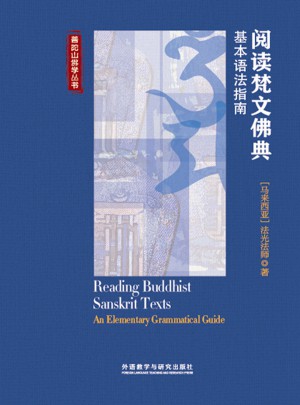
閱讀梵文佛典:基本語法指南
- 所屬分類:圖書 >外語>其他小語種
- 作者:(馬來西亞)[法光法師] 著
- 產品參數:
- 叢書名:無
- 國際刊號:9787513566711
- 出版社:外語教學與研究出版社
- 出版時間:2015-11
- 印刷時間:2015-11-01
- 版次:1
- 開本:32開
- 頁數:--
- 紙張:膠版紙
- 包裝:精裝
- 套裝:否

閱讀梵文佛典:基本語法指南》是法光法師介紹梵文學習的經典之作,也是普通讀者入門與研習梵文的佳品。全書由英文寫成,但其中參考了諸多中文佛典和梵文經典佛典,篇章分布得當,內容由淺入深,每篇章還配有相應試題練習。作者在書中對梵文經典的結構,梵文單詞詞性及各種常見的梵文表達方式進行了細致入微的分析。
此書是佛學大師法光法師的傾力之作,書中篇章分部詳略得當,并不時加入漢語與梵文的佛典引用,讓讀者能夠對梵文的基本語法結構得到一定地了解。
法光法師(Bhikkhu KL Dhammajoti)系香港大學佛學研究中心教授,佛學原典系的教授和系主任,是研究佛學專科阿毗達磨 (對法)的。精通佛教典籍文字,包括中文古文、梵文、 巴利文、藏文。
Preface
Abbreviations
Lesson 1
1.1 The Sanskrit Alphabet
1.2 Three genders of nouns: masculine (m), neutral (n
and feminine (f
1.3 Three numbers: singular (sg), dual (du) and plural (pl
1.4 Case (vibhakti
1.5 Masculine nouns ending with -a
1.6 Adjectives
1.7 Omission of the verb "to be" in a sentence
1.8 Indeclinable particles ca, vā, api, na and the affix –vat
Lesson 2
2.1 The accusative case (acc
2.2 The ablative case (abl
2.3 Accusative and ablative case of m nouns ending in -a:
buddha
2.4 Neutral nouns ending in -a: phala
2.5 Sanskrit verbs
2.6 Verbal prefixes
2.7 Three grades of strengthening of vowels
2.8 Verbs of classes I, IV, VI, X
2.9 Particle iti
2.10 The emphatic particle eva
Lesson 3
3.1 The dative case
3.2 Genitive used in the dative sense
3.3 Expression of "have"
3.4 The vocative case
3.5 The declensions learned so far
3.6 Declension of f ā-ending noun: praj?ā
3.7 Suffixes -tā, -tva , -tas
3.8 Class VI verbs
3.9 Class IV verbs
3.10 Class X verbs
3.11 Summary of differences between verbs of
class I, IV, VI and X
3.12 Personal pronouns: 1st person stem: mad,
2nd person stem: tvad
Lesson 4
4.1 Declension of m nouns ending in -u
4.2 Declension of n nouns ending in -u
4.3 Declension of pronoun sa? (m) `he`/`that`
and e?a? (m) `this`
4.4 Declension of pronoun tat (n) `it`/`that`
and etat `this`
4.5 The enclitic pronoun enam
4.6 The causative verbs
4.7 The denominatives
4.8 The instrumental case
4.9 Past Passive Participles (PPP
Lesson 5
5.1 Declension of m nouns ending in -i : agni
5.2 Declension of n nouns ending in -i : vāri
5.3 Declension of f nouns ending in -i : jāti
5.4 Declension of f nouns ending in -ī : nadī
5.5 Declension of pronoun sā (f
5.6 Declension of demonstratives: ayam (m),
idam (n), iyam (f
5.7 Declension of interrogative pronouns: ka? (m),
kim (n), kā (f
5.8 The interrogative particles, api and kim
question markers
5.9 Parasmaipada and ātmanepada verbs
5.10 Paradigm for the conjugation of ātmanepada verbs
5.11 Gerunds
5.12 Hard and soft consonants
5.13 Introduction to sandhi rules
5.14 Primary and secondary suffixes
Lesson 6
6.1 Possessive suffix -in
6.2 "Subjective genitive" and "objective genitive"
6.3 Future passive participles (FPP. Also known as
gerundive
6.4 Relatives
6.5 Numerals (cardinals
Lesson 7
7.1 Declension of bhagavant (m
7.2 Possessive suffixes `-mant` and `-vant`
7.3 The Future Tense
7.4 Compounds — dvandva and tatpuru?a
7.5 Infinitive
7.6 Verbs formed from noun/adjective + √bhū and + √k?
7.7 Declension of the demonstrative asau (m
7.8 Declension of the demonstrative ada? (n
7.9 Declension of the demonstrative asau (f
Lesson 8
8.1 Declension of noun ending in –an: ātman, rājan,
karman, nāman
8.2 Class II verbs
8.3 Verb standing at the beginning of a sentence
8.4 The Passive Voice
8.5 Present participles (PrP
8.6 Karmadhāraya compound
8.7 Avyayībhāva compound
Lesson 9
9.1 Declension of manas (n) and sumanas (m,f
9.2 Declension of āyus (n
9.3 Declension of sa?pad (f), vāc (vāk) (f
9.4 Some irregular declensions: grāma?i? (m),pathin (m
9.5 Class IX verbs
9.6 The imperative mood (ipv
9.7 Numbers (ordinal
Lesson 10
10.1 Declension of agent nouns
10.2 Periphrastic Future
10.3 Conjugation of Class V Verbs
10.4 Conjugation of Class VIII Verbs
10.5 The optative mode
10.6 Bahuvrīhi compounds
Lesson 11
11.1 Past Participle Active (PPA
11.2 Conjugation of Class III verbs
11.3 The imperfect tense
11.4 Conjugation of the present and imperfect
of √budh, √j?ā and √dā
11.5 Locative Absolute and Genitive Absolute
Lesson 12
12.1 Class VII verbs
12.2 Conditional tense (condl
12.3 The Perfect Tense (pf
12.4 Comparative and superlative suffixes
Lesson 13
13.1 The Aorist Tense
13.2 Prohibitive (injunctive
13.3 Desiderative and Intensive (/frequentative
English translation of the Vajracchedikā Praj?āpāramitā
Appendix: Sandhi tables
Useful References
Vocabulary
Index
在佛教文化中,有一樁很值得自豪的事業,就是典籍的整理。佛教典籍,作為三寶住世的重要載體,自來受到教界、學界和廣大信眾的珍視。在佛陀涅槃后不久,就開始了次結集,可以看作是佛教典籍整理的源頭。從此之后,結集不斷進行。
同時,佛教典籍也在增加,——大乘經典的出現,諸類注疏的繁興,后世著述的涌現,盡管數量巨大,也都得到不斷的整理。只要看看各種不同的《大藏經》,就可以知道佛教典籍整理的成果是何等豐碩了。這些整理工作的成績令人驚嘆。首先,佛教典籍整理的工作遍及寬廣的地域,產生了包羅宏富的藏經體系。世界上現存的《大藏經》有巴利語、漢文、藏文三大體系,有巴利語、漢文、藏文、西夏文、蒙文、滿文、日文七種文字流傳。這還不包括只剩下少數零散貝葉本或紙寫本的早期梵文經典,以及雖有刊刻卻未見傳世實物的契丹文《大藏經》。即使在世界文化史的范圍內,也很難看到如此宏富的典籍體系。其次,佛教典籍整理的工作貫穿著長久的歷史,各種體系的藏經都在不斷地完善著。就漢文《大藏經》來說,至遲在隋代,初期的手寫《大藏經》已經流傳。同時還有石刻藏經,如房山云居寺就保存有從隋至明的各類石刻經版一萬五千余塊。印刷術的發明,使得北宋初年就出現了部刻版《大藏經》——《開寶藏》。此后,我國歷代官、私所修的《大藏經》,目前已知的計有二十一種。在國外編印的漢文《大藏經》也有九種:朝鮮的《高麗藏》初雕、再雕兩種,日本的《弘安藏》《天海藏》《黃檗藏》《弘教藏》《卍字藏》《卍字續藏》《大正藏》七種。目前,大陸和臺灣正在分別編纂的《中華大藏經》和《佛光大藏經》,都力圖成為能夠體現水準的新版《大藏經》。在我國沒有任何一部典籍匯編,具有大藏經這樣不斷完善的歷程。比起數十部大藏經來,名聞遐邇的《四庫全書》顯得孑然孤立。
透過這些整理工作,使我們看到一代代佛教典籍整理者的虔敬和匠心。他們的虔敬,使得藏經的整理不藉外緣。俗話說,"盛世修典",典籍的整理總需要一個太平盛世提供種種物質的支持。但是,藏經的編修卻并不如此,即使在亂世,這個工作也不曾停頓。信仰給予了這個工作無量的支持,人世的滄海桑田又何足搖動?他們的匠心,卻又使得藏經的整理為善用外緣。只要利于佛教典籍的流傳,他們無不擇取。貝葉上,紙帛上,碑石上,佛教典籍無處不在。我們在早的紙質印刷品上看到的,是佛經。我們現在能夠利用的為完善的中文典籍電子檢索系統,是《大藏經》。他們從未錯失時運所賦予的機緣。
……
當然,這個設想是過于宏大了,也遠遠超出了我們目前的實力。但是發一個宏愿,必將有一份動力。我們相信,經過長期不懈的努力,一定能夠為佛教典籍的長久流傳做一份貢獻。何況,普陀山自來就有的文化傳統,眾多善知識的熱心參與,都給了我們信心。同時,我們也熱忱期望,有更多的同道來參與這個事業。法門無量誓愿學。學佛法,必然從典籍開始。整理佛教典籍,將是我們中國佛學院普陀山學院義不容辭的責任。
Sādhu
好評!
下次還來買
是英文原版不是譯本
不能更贊
書在讀著呢,不錯,希望當當多搞些活動,O(∩_∩)O。
印刷很好,要細細看。
當你看到這個評論的時候說明我對這個商品是滿意的
Sanscrito grammatica
學習學習,了解一下梵文
很好,不錯的。
質量還可以。
專業,全面,內容豐富
有興趣可以看看
推薦購買!
佛教梵語,不是很正的梵文。但是這本書感覺是梵語教材里面最適合自學的,期待早日出漢譯本。